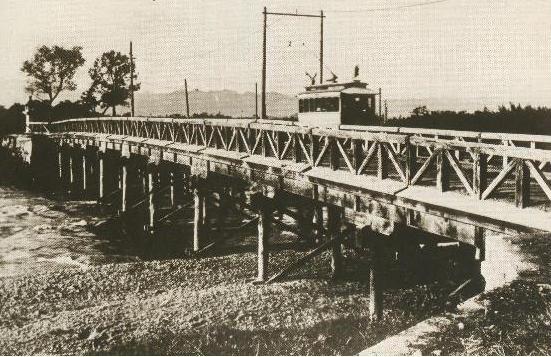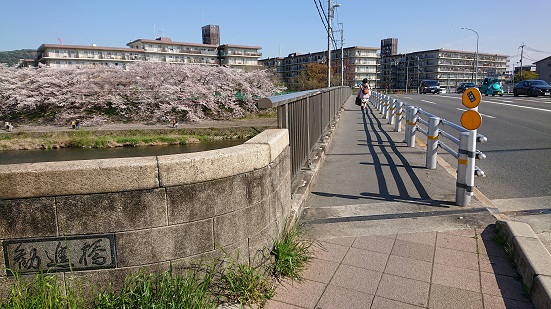Kanjinbashi Bridge
|
When you walk from Kyoto Station southward along Takeda-kaido Street (route 24), you will cross the Kamogawa River at Kuzebashi street. The bridge over Kamogawa River which you cross is called "Kanjinbashi Bridge". "Kanjin" means to contribute for religious purposes such as for the building or repairing of a temples or shrines. So the people had to pay a toll to use this bridge at the old times. A pay bridge was called the "Zenitori (charged) - bashi (bridge). This bridge was also called to "Zenitori - Bashi" at these days. Although it is located in the old Rakugai, this bridge had little historical significant, but it did appear twice in the Shinsengumi activity log. At first, in June 1864, when the Choshu force, infuriated by the Ikedaya incident, came to Kyoto in large numbers, the Shogunate troops, including the Aizu clan soldiers and the Watchmen, set up on Kujo Kawara; but Shinsengumi also set up a camp flying the flag of Makoto under Zenitori-bashi. This ultimately led to the Hamaguri Gomon Incident. Next, in June 1866, it appeared Zenitori-bashi was where Takeda Kanryuusai, who until then had been in a high position in the Shinsengumi and was suspected to be in collusion with the Satsuma clan, was slayed by Saito Ichi. At that time, "Kanjinbashi Bridge” seemed to be a small bridge with no railings, but in the Meiji era, to also allow for trams to pass through, it had become a rather large bridge. 
The picture was taken at the place where the street car was running on the Kanjinbashi Bridge. The street car of Fushimi line opened to traffic in August, 1904. The bridge was made of wood and we can see its two separated lanes, the right lane (in the back) for the street car and the left lane (in the front) for pedestrians. Previously, the big character (大) of five giant bonfires ( Daimonji festival) could be seen as far away as from the eastern end of the bridge, but in 1997 due to the renovation of Kyoto Station it became invisible. Until the 1970s, there were large dyeing and weaving factories around; in addition, large-scale condominiums were built. In 2011, the expressway called Hanshin Expressway No. 8 Kyoto Line was completed. And so the factories disappeared and the scenery changed completely. The cherry blossoms on the bank around Kanjinbahi are in full bloom at Spring. 
|
|
| Thanks to Mr. D.M. |